 Countdown
Countdown
 Countdown
Countdown
The discus throw is a track and field event where athletes throw a heavy, round-shaped disc as far as possible while remaining inside a 2.5-metre diameter circle. The winner is the athlete who throws the discus the farthest distance.
The discus can be traced back to the ancient Olympic Games in 708 BC
The Greek poet Homer referenced the discus in The Iliad's description of the funeral games for Patroclus in around 800BC
The discus was introduced as part of the pentathlon in the Ancient Olympics of 708BC (the first Olympics were held in 776BC)
The enduring image of the Greek discus thrower comes from the iconic 5th century BC statue by the great sculptor Myron
The discus weighs 2kg for men (22cm in diameter) and 1kg (18cm in diameter) for women
The men’s discus was introduced as an event in the modern Olympic Games in 1896
The women’s discus made its Olympic debut at the 1928 Games
To break a world record, discus throwers must possess incredible strength, speed, balance and explosive power.
The first ratified women’s discus world record was set by French athlete Yvonne Tembouret in September 1923. She threw the discus 27.39m (89ft 10 1⁄4in). Less than a year later, in July 1924, fellow French athlete Lucie Petit-Diagre broke the record with 27.70m (90ft 10 1⁄2in).
The first woman to throw the discus more than 100ft was Maria Vidlakova, with 31.15m (102ft 2 1⁄4in) in October 1925. Ten years later, in June 1935, German athlete Gisela Mauermayer achieved 46.10m (151ft 2 3⁄4in). Mauermayer actually broke the record a further five times, with her longest throw being 48.31m (158ft 5 3⁄4in).
The first woman to achieve a distance of more than 60m was German athlete Liesel Westermann, with a throw of 61.26m (200ft 11 3⁄4in) in November 1967.
The current world record-holder, and the first athlete to throw the discus more than 75m, is German thrower Gabriele Reinsch who threw 76.80m (251ft 11 1⁄2in) in July 1988.
The first men’s discus world record was set by US athlete James Duncan in May 1912. He threw the discus 47.58m (156ft 1in). Duncan managed to hold the record until September 1924, when fellow US athlete Thomas Lieb achieved 47.61m (156ft 2 1⁄4in).
The first men’s discus thrower to achieve a distance of more than 60m was US athlete Jay Silvester with 60,56m in August 1961.
Over the next 24 years, the record was broken 18 times. Then, in June 1986, German athlete Jurgen Schult set a world record of 74.08m (243ft 1⁄2in). Schult retained the record-holder until April 2024, when Lithuanian athlete Mykolas Alekna threw 74.35m (243ft 11in). He is the current world record-holder.
There have been many celebrated athletes in the discus, which requires throwers to have a huge amount of upper body strength so they can consistently throw the discus in excess of 200ft.
Arguably the greatest men’s Olympic discus thrower of all time was Al Oerter, the first man to ever win gold in the same individual event at four successive Olympic Games, between 1956 and 1968.
More recently, Lithuanian athlete Virgilijus Alekna won back-to-back Olympics in 2000 and 2004, setting an Olympic record at the latter, while Gerd Kanter won gold in 2008 and bronze in 2012, and German Robert Harting won three back-to-back World Championships between 2009 and 2013. Sweden’s Daniel Stahl is a two-time world champion who won the Olympic title in Tokyo.
In the women’s event, Croatia’s Sandra Elkasevic is a two-time Olympic and two-time world champion, while USA’s Valarie Allman won gold at the Tokyo Olympics and has two world medals to her name. Other notable global medallists are three-time World Championships gold medallist Franka Dietzsch and Micheline Ostermeyer, who struck gold at the 1948 Games. She was also a famous concert pianist and a great-niece of the legendary French author Victor Hugo.

Throwing a discus requires a specific technique. Beginners will usually stand and twist their bodies while spinning, while experts and elite athletes will spin one and a half times – but this requires a strong and considered approach.
Here’s how to throw a discus using the correct technique:
Athletes stand at the back of the throwing circle, with their backs to the landing area. They grip the discus with their fingers and palm, with their hand in a claw-like position.
The athlete begins rotating their body while swinging the discus behind them to build momentum. They complete one and a half spins while maintaining balance and ensuring that they stay within the throwing circle.
The athlete transitions into the power position by rotating their hips to shift their weight to their front foot. At the same time, they stretch out their other arm for balance.
Once the one-and-a-half spins are complete and the athlete is facing the landing area, they transfer their energy from their lower body to their upper body. They swing their arm around to release the discus at a 40-degree angle, in a smooth but forceful motion.
After release, the athlete allows the throwing arm to follow through and the body continues to rotate. The athlete then starts to slow down, ensuring they maintain balance and stay within the throwing circle. After the discus lands, the thrower leaves the throwing circle from the rear.
There are several rules that athletes must abide by to ensure safety and fairness.
The standard size and weight of a discus depends on whether it’s being used in the men’s or women’s event:
Men’s - 2kg (4.4lbs) and 22cm in diameter
Women’s - 1kg (2.2lbs) and 18cm in diameter
The throwing circle is 2.5m in diameter.
The athlete must only grip the discus using one hand and it must not touch any other part of the body or clothing.
Athletes aren’t permitted to wear gloves or any additional grips with the exception of single finger tape to prevent injury.
The discus must land within the marked landing area, which is at a 34.92-degree angle.
It’s considered a foul throw if:
The athlete leaves the throwing circle before the discus lands
The discus lands outside the landing area
The athlete touches the top of the rim of the throwing circle during delivery
The athlete fails to throw the discus within 60 seconds of being called to the circle
The throw is measured to the nearest mark made by the discus upon landing.
Normally, each athlete shall be allowed three trials and the eight athletes with the best valid performances shall be allowed three additional trials.
The winner is the athlete with the longest legal throw. In the event of a tie, the winner will be the athlete with the next-best measure.
The weight of the discus depends on whether it’s being used in the men’s or women’s event. The men’s discus weighs 2kg (4.4lbs) and is 22cm in diameter. The women’s discus weighs 1kg (2.2lbs) and is 18cm in diameter.
For elite athletes, there are only two types of discus. The following are standard sizes and weights:
Men’s - 2kg (4.4lbs) and 22cm in diameter
Women’s - 1kg (2.2lbs) and 18cm in diameter
However, there are differences between discus implements that can alter your performance, so you may want to consider the following:
Hi or low rim weight
Rim finish or profile
Hi- or low-spin
Plate finish
Each type can make a difference to performance levels, depending on your skill and experience.
 LTU
LTU
 SWE
SWE
 SLO
SLO
 AUS
AUS
 JAM
JAM
 JAM
JAM
 GER
GER
 GBR
GBR
 USA
USA
 CUB
CUB
 USA
USA
 NED
NED
 CRO
CRO
 CUB
CUB
 USA
USA
 CHN
CHN
 CUB
CUB
 SWE
SWE
 GER
GER
 USA
USA







